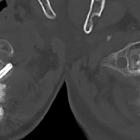Spondylodese








Spinal fusion is a broad term to denote the joining of two or more adjacent vertebral segments. Fusion can be congenital or acquired as a direct result of disease or deliberately following spinal surgery.
Congenital fusion
Fusion of two or more adjacent segments is encountered either as an isolated, usually incidental, finding or in a variety of conditions with multiple other defects.
Acquired fusion
Many disease processes can result in fusion of adjacent vertebrae including:
Operative fusion
Numerous procedures have been developed over the years to fuse spinal segments to treat a variety of conditions (e.g. spondylolisthesis, unstable spinal fractures, disc protrusions). It should be noted that it is osseous fusion than confers long-term stability and that fusion solely with instrumentation will eventually fail .
Hardware
A number of components are used to achieve fusion. These include :
- connecting rods
- Hartshill rectangles
- interbody spacers/cages
- laminar hooks
- plates
- screws
- pedicle screws
- facet joint screws
- translaminar screws
- vertebral body replacement devices
- wires
Techniques
One or more of the above-mentioned components can be utilized to achieve fusion. Some of the more common procedures include:
- anterior cervical discectomy and fusion (ACDF)
- anterior lumbar interbody fusion (ALIF)
- corpectomy fusion
- extreme lateral interbody fusion (XLIF)
- posterior lumbar interbody fusion (PLIF)
- transforaminal lumbar interbody fusion (TLIF)
Siehe auch:
und weiter:

 Assoziationen und Differentialdiagnosen zu Spondylodese:
Assoziationen und Differentialdiagnosen zu Spondylodese:

